Deciphering the Pickleball Court
The court is the canvas upon which the beautiful game of pickleball is painted. Understanding its dimensions and layout is crucial for every player, as it not only defines the playing field but also influences strategies and gameplay dynamics.
Court Dimensions and Layout
A standard pickleball court measures 44 feet long and 20 feet wide, with distinct lines that serve vital purposes. The net height is 36 inches at the sidelines but dips to 34 inches in the center a subtle reminder of the obstacles players must overcome. The official court includes areas marked as sidelines, baselines, and a centerline, each playing an integral part in the game’s flow.
- Sidelines: These lines mark the boundary of the court width.
- Baselines: They indicate the back limits of the court for both players.
- Centerline: This divides the two service courts.
Each of these lines contributes to the legal definition of in or out plays, guiding players in their positioning and shot selection. By grasping the physical parameters of the court, players can better navigate their movements during play, akin to chess pieces moving strategically across a board in pursuit of victory.
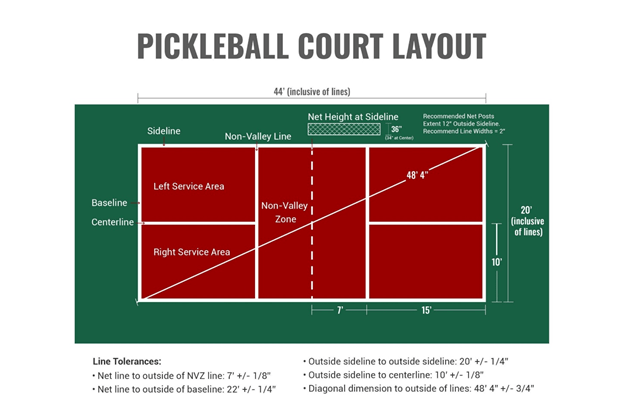
The Three Zones of Play
Within the court, there are three distinct zones that players must master to excel each with its own strategic significance.
- Right/Even Service Court: This is where players serve to start the game from one side of the court.
- Left/Odd Service Court: Players switch to this court to serve once they gain points.
- Non-Volley Zone (or Kitchen): A crucial area just beyond the net where players cannot hit volleys, adding a unique twist to the gameplay.
The strategic implications of these zones cannot be understated. Understanding when and how to position oneself within each zone can greatly influence the outcome of a rally, just as a well-paced dance requires awareness of tempo and space.
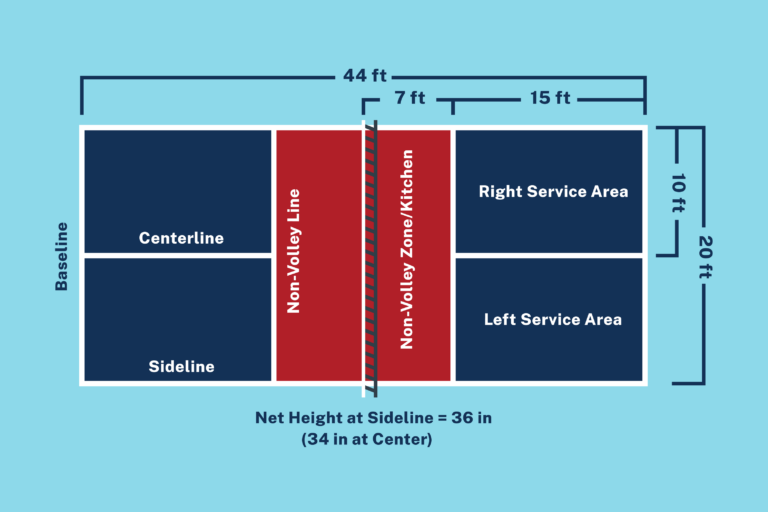
Serving: The Game Begins
Serving is akin to the starting gun in a race; it marks the moment the competition truly begins. The way a player serves can set the tone for a dynamic rally.
Types of Serves
There are two primary types of serves in pickleball: the traditional volley serve where the ball is hit out of the air and the drop serve, executed after the ball has bounced. Understanding the mechanics and rules governing these serves is crucial for both legal play and maximizing scoring opportunities.
- Volley Serve: This requires the ball to be tossed slightly into the air and hit before it touches the ground.
- Drop Serve: Players can let the ball bounce before hitting it, introducing an element of versatility to the serve.
While employing these techniques, players must remain vigilant about court positioning and the potential for faults, as accurate serving can be a game-changer, akin to a well-placed power shot in tennis.
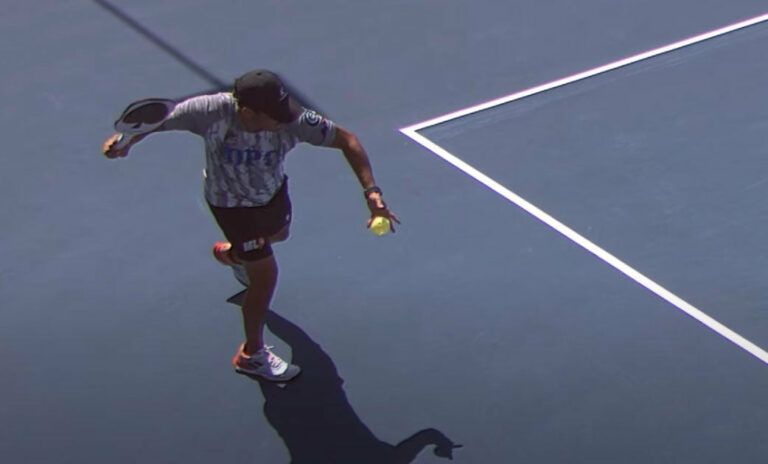
Legal Serving Motion and Positioning
Integral to the serve is the requirement of an underhand motion. Players must ensure that their paddle remains below their waist upon contact with the ball. Failing to adhere to this rule can result in a fault, impacting the scoring dynamics of the game.
The server must stand behind the baseline while serving, reinforcing the necessity for precise execution to avoid foot faults. Much like an archer ensuring proper stance before firing an arrow, positioning in pickleball is crucial.
The Two-Bounce Rule: A Pickleball Essential
Understanding the two-bounce rule is critical in helping players sharpen their skills and comprehend the flow of the game. This rule harmonizes the competition, providing a fair start to every rally.
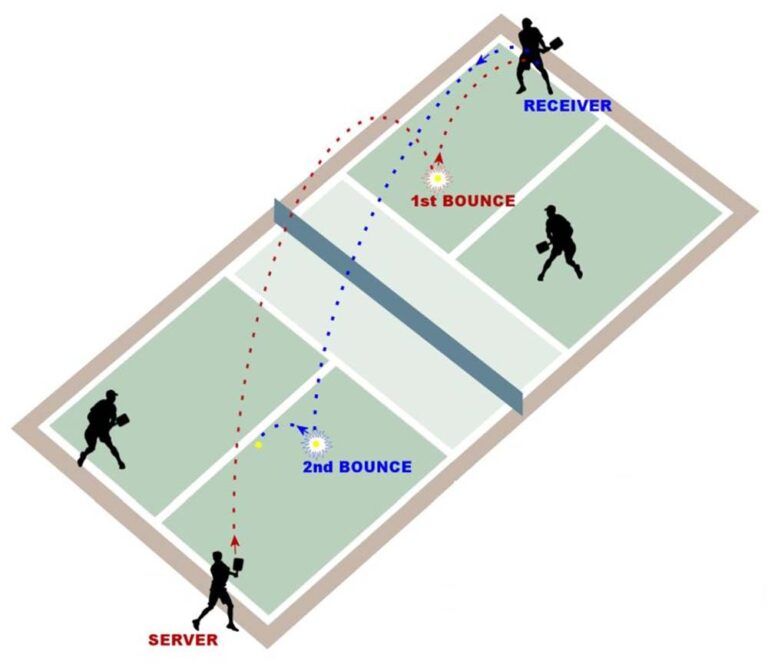
Understanding the Two-Bounce Rule
This pivotal rule asserts that the receiving team must allow the serve to bounce before returning it, while the serving team must also let the return bounce. Consequently, this establishes a rhythm to the game and prevents aggressive net play immediately following a serve. Here’s how the sequence plays out:
- Player A serves.
- Player B lets the ball bounce before returning it.
- Player A is now permitted to volley.
This flow creates longer rallies and prevents quick engagements that might disadvantage the returning player, promoting a sense of fair play and measured strategy.
Strategic Implications of the Two-Bounce Rule
From a strategic perspective, the two-bounce rule discourages players from immediately rushing the net after the serve, promoting well-thought-out positioning. Players are often forced to adjust their stances and shot selections, leading to more engaging rallies that showcase skill over speed.
The anticipation and positioning that comes into play as a result not only enhance the experience for both players but also for spectators who appreciate the sport's strategic depth. It incorporates a tactical chess-like dimension to every interaction on the court.
The Non-Volley Zone (The Kitchen): A Pickleball Quirk
One of the most unique features of pickleball is its non-volley zone, affectionately known as the "kitchen." This area adds an intriguing layer of complexity to the game.
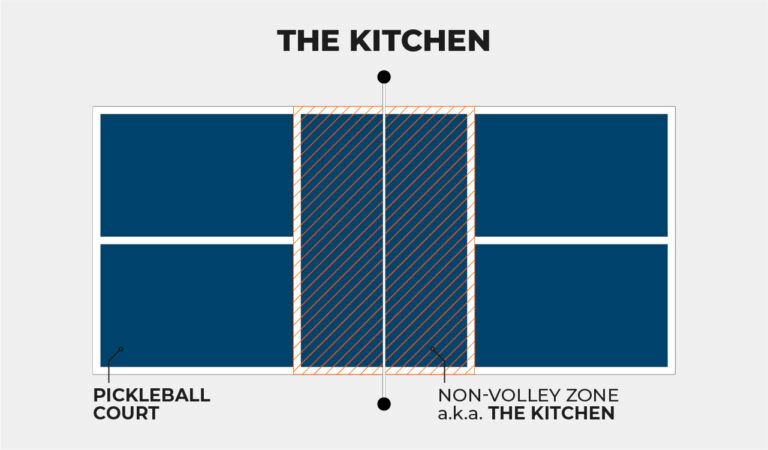
What is the Kitchen?
The kitchen extends 7 feet on either side of the net, creating an area where hitting volleys is strictly prohibited. Understanding the boundaries of the kitchen is essential; if players step into this zone while attempting to volley, they risk committing a fault.
The kitchen acts as a buffer that can be strategically used to one's advantage, compelling players to employ finesse rather than brute strength when engaging close to the net. Recognizing when to enter this zone or retreat is fundamental much like deciding whether to dive into the deep end or wade slowly into the water.
Volleying Restrictions and Consequences
The implication of breaching kitchen boundaries carries significant consequences. Actions that constitute a kitchen fault include:
- Volleys while any part of the foot is touching or in the kitchen.
- Carrying momentum into the kitchen after hitting a volley.
Such faults can alter the momentum of the game, leading to lost rallies and point opportunities. Just as a misstep can lead to a fall in high-stakes dance, a kitchen fault can result in critical swings in scoring.
Legal Movements and Shots in the Kitchen
Players are permitted to enter the kitchen to play balls that have bounced, adding strategic depth to their movements. This timing and positioning allow players to mix aggression with caution, creating an exciting dynamic during points. Understanding the kitchen’s boundaries and learning how to navigate them effectively can be the difference between victory and defeat.
Rallying and Scoring: The Heart of the Game
At its core, pickleball is about rallying and scoring elements that bring the sport to life.
Playing the Rally
A typical rally begins with the serve and continues as players return the ball back and forth across the net. Each player must strive for precision and control, executing various shots such as drives, dinks, volleys, and lobs. These shots are not just functional; they resemble artistic strokes on a canvas, each reflecting the player's style and intent.
- Drives: Powerful shots aimed at the back of the court.
- Dinks: Soft, delicate shots that clear the net but land close to it.
- Volleys: Quick shots made before the ball touches the ground.
- Lobs: Arcing shots that fly over opponents.
Employing these techniques effectively prepares one to engage in compelling exchanges, leading to captivating plays that resonate with fans and players alike.
Winning a Rally
Winning a rally can happen in several ways:
- Opponent's Errors: Here, players capitalize on their opponents' mistakes, such as hitting the ball out of bounds or into the net.
- Faults: An opponent may commit a rule violation, such as a kitchen or foot fault.
Understanding the many paths to victory is akin to recognizing all the strategies in a card game; each option presents opportunities for triumph.
The Unique Pickleball Scoring System
Scoring in pickleball operates on a unique principle points can only be scored by the serving team. This means that rallying remains tied to the server's success, creating a distinct pressure on them. Understanding how the scoring system works allows players to focus their strategies, pushing the dynamics of the game in their favor.
Serving Rotation and Side Out
Mastering the rotation of serves is essential for any player looking to excel in doubles play, as understanding the format can significantly impact the rhythm of the game.
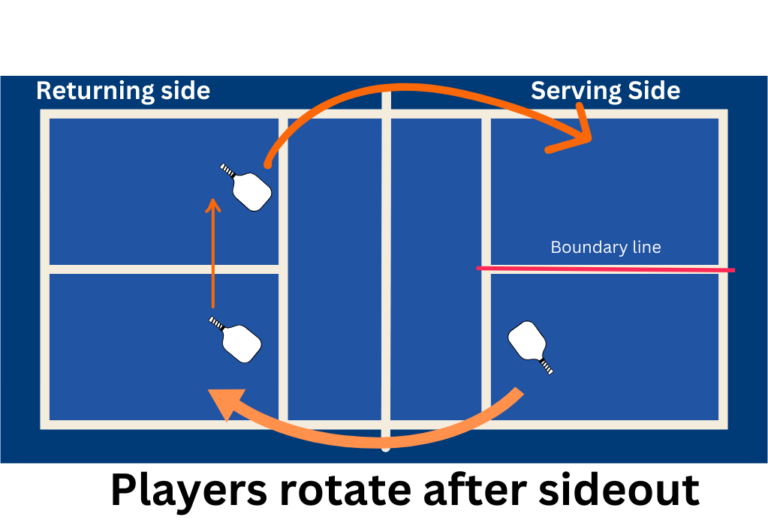
Alternating Serves in Doubles
In a doubles match, service alternates between the two players on each team. Each player on a team serves until they commit a fault, at which point the serve goes to the opposing team. The rule fosters teamwork and strategic coordination, as partners must work together to score points, transitioning seamlessly between offense and defense.
Understanding Side Out
A "side out" occurs when the serving team fails to score, resulting in the other team receiving the serve. This shift creates immediate changes in the dynamics of the game, recalling the fast-paced exchange of a tennis match where the momentum shifts with each stroke.
The First-Server Exception in Doubles
An interesting rule in doubles is the first-server exception, which impacts how teams operate, particularly during crucial moments.
What is the First-Server Exception?
Under this rule, only the first server on a team can serve twice before a side out occurs. This means that if the first server faults, the second player on the team will only get one chance to serve. This encapsulates the blend of skill and strategy that defines pickleball, as the first player bears significant responsibility for the team's initial scoring opportunities.
Why the Exception Exists
This rule exists to promote fair play, ensuring a balanced landscape where each player has an equal opportunity to serve and contribute to points. It adds a layer of strategy where players must prepare not only for their individual play but also for the overall harmony of their team.
Faults: Knowing the No-Nos
Understanding faults in pickleball is critical; they can alter the course of the game, transforming potential victories into hard lessons.
Common Types of Faults
Several types of faults can occur in pickleball, including:
- Serving Faults: This includes foot faults, serving out of bounds, or serving into the net.
- Gameplay Faults: Accompanied by hitting the ball out of bounds, volleying in the kitchen, double bounces, or touching the net.
Recognizing these faults is analogous to recognizing traps in a competitive game; awareness allows players to navigate with caution, mitigating their risks.
Consequences of Faults
The repercussions of faults can vary significantly:
- A fault by the serving team may cause either a side out or result in the second server having a turn.
- Conversely, a fault by the receiving team results in a point awarded to the serving team.
Understanding these outcomes is paramount in strategy-building, enabling players to mitigate losses and optimize their potential gains.
Calling Faults
Calling faults is rooted in trusted sportsmanship and fair play. Each player is responsible for being vigilant and honest regarding their own plays and the integrity of their opponents’ moves. This respect for the game enhances the overall atmosphere, imparting a sense of community amid competition.
Pickleball Etiquette: Beyond the Rules
Etiquette in pickleball is as significant as the rules themselves, defining the respect players hold for one another and the game.
The Importance of Clear Communication
Clear communication is key in pickleball, particularly during rallies and scoring. Players are encouraged to call scores loudly and clearly to ensure everyone is on the same page, fostering a spirit of camaraderie. Communication can be the glue that holds a team together, avoiding unnecessary confusion.
Respect for Opponents and Partners
Mutual respect among players whether on a team or adversaries sets the groundwork for a positive experience. A simple acknowledgment of good plays, or a sportsmanlike gesture after a close match, reinforces the ethical foundations of the sport.
Minimizing Distractions
Minimizing distractions can enhance focus during matches. Players should strive to maintain an environment conducive to concentration, avoiding unnecessary chatter or movements that could disrupt gameplay. Just as a calm wind can direct a soaring kite, a focused court encourages better performance and joy in play.
Ready Position and Serving Etiquette
All players should adopt a ready position before serving, reflecting readiness and engagement in the game. Additionally, serving players must respect their opponent's readiness, delaying the serve if the opponent is not prepared.
Beyond the Basics: Additional Resources and Tips
With the ever-evolving landscape of pickleball rules, players can benefit from diving deeper into official content provided by governing bodies.
Diving Deeper into Pickleball Rules
To further enhance understanding, players can access the official USA Pickleball rulebook online. These authoritative resources are structured to keep players updated with any changes or nuances that may arise within the sport.
Mastering Pickleball Strategy and Skills
Beyond understanding the rules, players are encouraged to engage in drills and practice sessions to refine their strategic acumen. Joining local clubs, attending workshops, or simply practicing with friends can dramatically elevate one’s skill set, merging knowledge of the game with its execution.
Joining the Pickleball Community
Pickleball thrives in a community-centric environment. By joining clubs and participating in events, players can share experiences and cultivate a culture of learning and improvement. Building these connections not only enriches their experience but also strengthens the sport's growth.
Conclusion
As pickleball continues to flourish, understanding its rules and etiquette becomes increasingly essential for players of all levels. Through clarity in the game’s structure and a spirit of sportsmanship, participants can elevate both their performance and enjoyment. Every rally, serve, and match showcases not just skill but also the community and joy that pickleball embodies. As you step onto the court, armed with these insights, remember: the true essence of pickleball lies not just in points scored, but in the friendships forged and the unforgettable moments experienced. Embrace the game, respect its rules, and savor every bounce!










